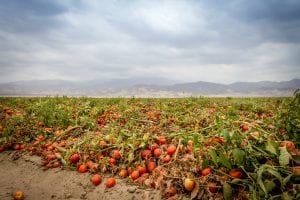A type of resistance-breaking tomato spotted wilt virus is continuing to spread through production areas of California. The virus has been an issue for growers for a number of decades, but the latest strain is particularly challenging. A single resistance gene that is used in almost all tomato varieties now is no longer adequately protecting from the virus. Since 2016 the issue has now become even more of a problem for growers.
“At this point, all of western Fresno County has this resistance-breaking strain. It’s now been recorded outside of Fresno County, through Merced into Kings and most recently recorded in Kern County as well,” said Tom Turini, Cooperative Extension Vegetable Crops Farm Advisor in Fresno County. “The distribution was ubiquitous. Wherever we had tomatoes we could find some spotted wilt. In some areas, it caused a great deal of damage. In some places, we were seeing levels that were clearly impacting yields. Other places, it was spotted wilt in combination with some other issues that brought our yields down.”
The strain of resistance-breaking tomato spotted wilt virus is creating issues for both fresh market ad processing tomatoes. Turini suggests taking an integrated management approach to the problem. A good sanitation program will help to address the vector of the virus. There are several options available to manage thrip populations. Work is also being done to evaluate which tomato varieties appear to be the most susceptible to this strain of the virus. Researchers are also looking the potential of alternative sources of resistance that may be a viable option.
“Before something is released in terms of genetic material that is going to perform at adequate levels for our producers and be resistant to this virus, that’s going to be a few years off,” Turini noted. “I had a study at the Westside Research and Extension Center last year and year before and there are some entries that looked like they were lower levels of disease, but nothing had zero.”











